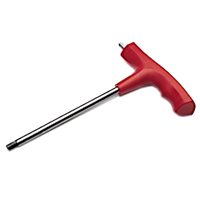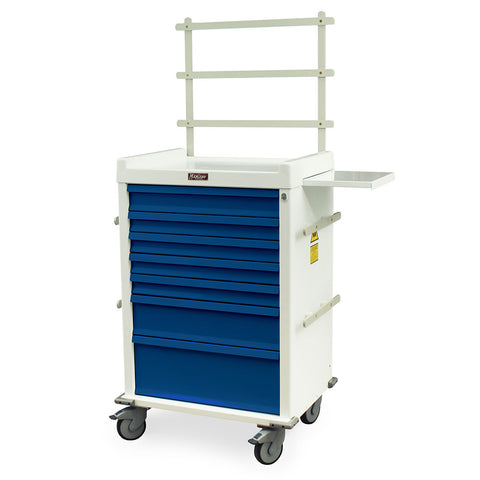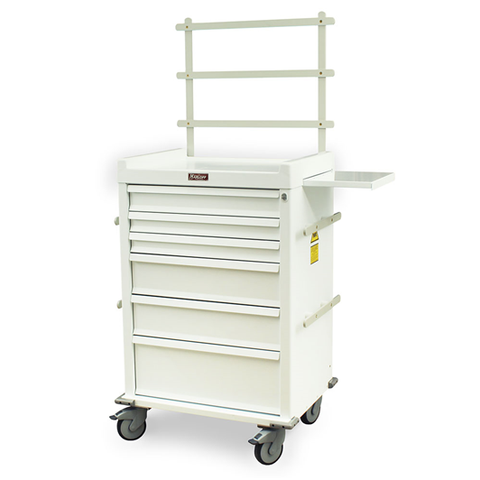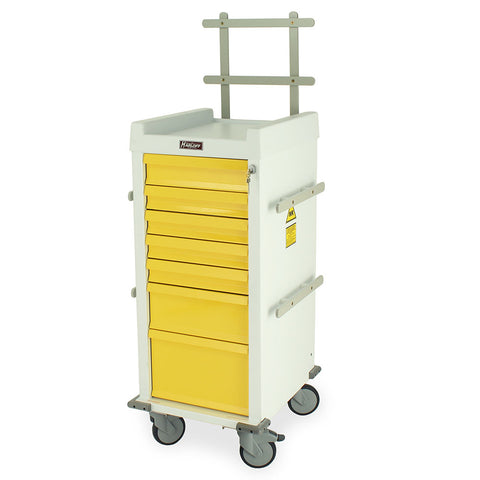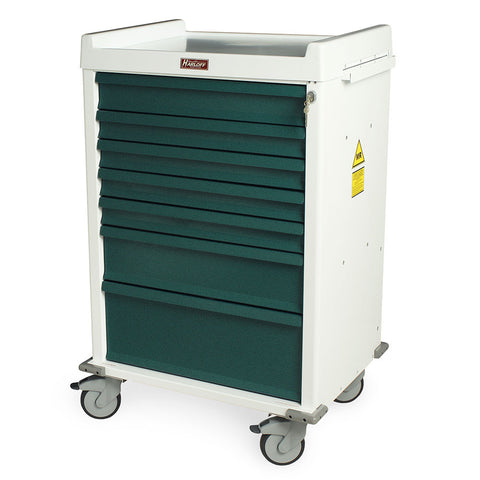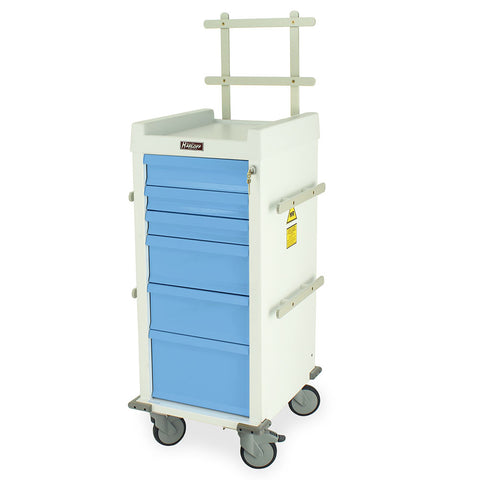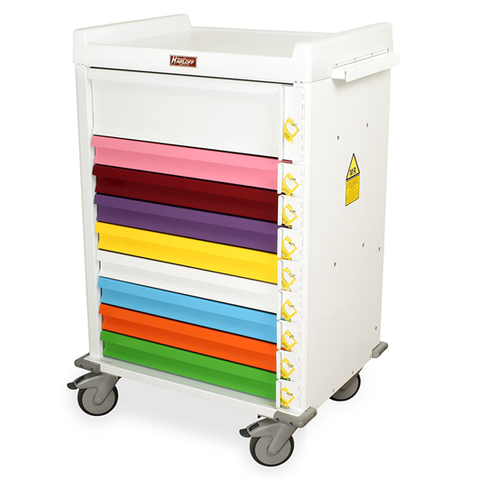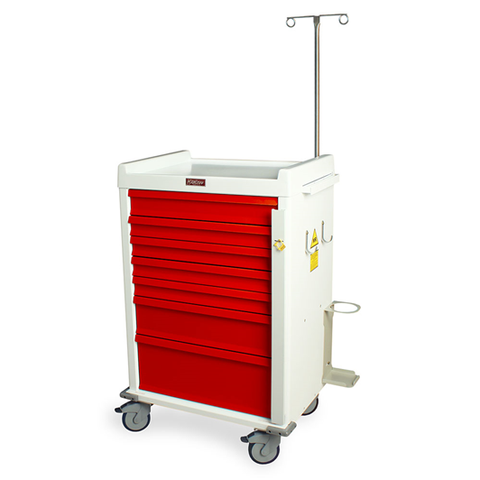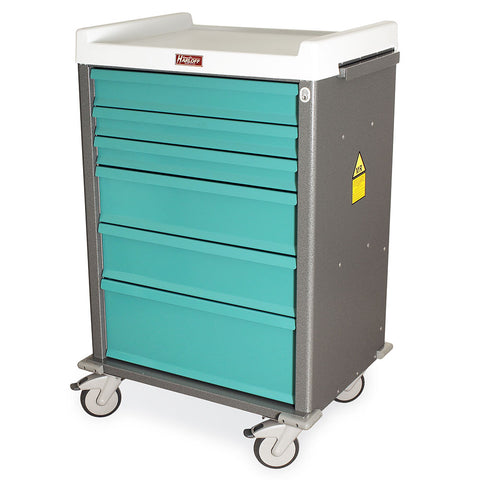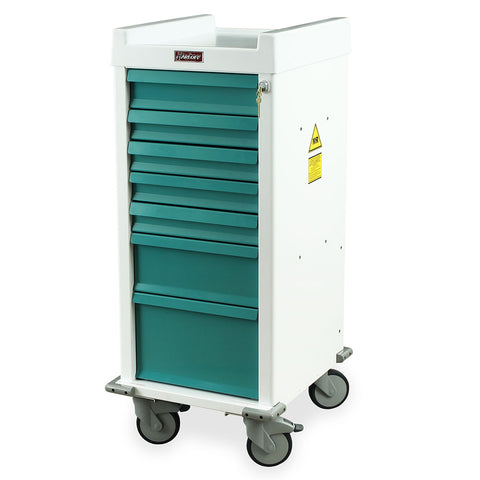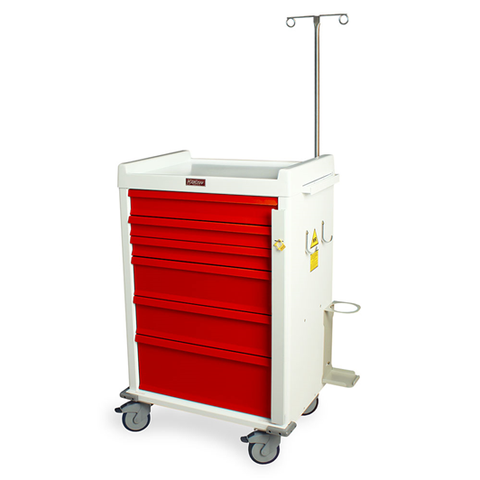
Moving patients safely in an MRI environment is more than just pushing a stretcher or wheelchair from point A to B. MRI patient transport is a critical element in hospital workflow, impacting patient safety, scan quality, and staff efficiency. Standard hospital stretchers, gurneys, and wheelchairs often contain ferromagnetic materials or conductive parts, which can become extremely dangerous inside MRI suites. Even small metallic objects can turn into high-speed projectiles, while conductive components may heat during scanning, leading to injury.
At MRI Med, we provide specialized MR Conditional stretchers, wheelchairs, and accessories that meet ASTM F2503 standards, ensuring safe transport of patients under MRI conditions. Our products combine non-magnetic construction, ergonomic design, and configurable features to accommodate a wide range of patient needs. Using certified devices improves workflow, reduces risk, and guarantees patient comfort during transport into and out of MRI suites.
Why MRI Patient Transport Requires Specialized Equipment
MRI patient transport is inherently different from transporting patients in conventional hospital settings. MRI systems generate strong static magnetic fields, time-varying gradients, and radiofrequency (RF) energy. These physical forces interact with metallic and conductive materials in ways that can compromise patient safety or the quality of imaging.
Magnetic Field Risks During Transport
Even small pieces of ferromagnetic metal can become dangerous projectiles when introduced into an MRI environment. Conductive components, like wires or metal tubing, can experience RF heating, potentially causing burns. Devices not tested for MRI environments can also create artifacts in the images, leading to misdiagnosis.
MRIMed addresses these risks with MR Conditional devices such as the Non-Ferrous Height Adjustable Stretcher. This stretcher features a non-magnetic aluminum frame, a hydraulic height adjustment system, and a 500-lb load capacity. Its MR Conditional certification ensures safe use under specified field strengths and RF exposure limits, allowing healthcare staff to transport patients safely and efficiently.
For bariatric patients, the MRIMed Stainless Steel Non-Magnetic Bariatric Stretcher accommodates up to 700 lbs and provides a padded, comfortable surface. Its fold-down side rails and adjustable backrest maintain patient security during transfer, while non-magnetic construction ensures safety in MRI fields.
Transitioning from Emergency Room to MRI Suite
Patient transport often starts from the emergency room, where patients arrive on standard hospital stretchers. These devices are typically MR Unsafe and cannot be taken into MRI suites. Safe transport requires transferring patients onto MR Conditional equipment.
The Non-Ferrous Height Adjustable Stretcher allows smooth lateral transfers. Its adjustable height, safety rails, and optional IV pole and oxygen cylinder holders facilitate safe movement without interrupting ongoing care. By minimizing the number of handoffs and using MR Conditional devices from the start, hospitals reduce the risk of accidents and maintain scan schedules.
For workflow guidance, see our related article: "How to Design an MRI Suite Transport Workflow".
MRI-Conditional Transport Options
To maintain MRI safety, hospitals should rely exclusively on MR Conditional stretchers, wheelchairs, and accessories. These devices have been rigorously tested for specific field strengths and RF exposures and are labeled with detailed usage parameters.
Stretchers and Gurneys
Non-Ferrous Height Adjustable Stretcher: Ideal for standard adults, this stretcher supports up to 500 lbs and allows smooth lateral and longitudinal patient transfers. Its hydraulic height adjustment minimizes the risk of musculoskeletal injuries for staff. Optional attachments, including IV poles and oxygen holders, ensure uninterrupted patient care during transport.
MRIMed Stainless Steel Non-Magnetic Bariatric Stretcher: This stretcher is designed for heavier patients, up to 700 lbs. It features a padded surface, adjustable backrest, and fold-down side rails. The non-magnetic stainless steel construction ensures safety in high-field MRI environments while maintaining patient comfort and stability.
These stretchers are engineered for workflow efficiency. Staff can position them near the MRI scanner and secure patients with MR Safe straps before scanning. Reducing manual lifting decreases the risk of staff injuries and enhances overall transport efficiency.
Wheelchairs
Patients who do not require full recumbent positioning can use MR Conditional wheelchairs, which allow upright transport while maintaining MRI safety.
-
MR Conditional 18-inch Wheelchair with Fixed Footrests: Lightweight, compact, and ideal for narrow corridors. Supports up to 250 lbs, providing secure seating for adult patients.
-
MR Conditional 24-inch Wheelchair w/ Flip-up Arms & Removable Footrests: Medium-sized option supporting 350 lbs, with removable footrests for smooth lateral transfers.
-
MR Conditional Bariatric 26-inch Wheelchair w/ Flip-up Arms & Removable Footrests: Designed for heavier patients up to 550 lbs, with reinforced frames and flip-up arms for easy access to the scanner.
Wheelchairs are often used in multi-step transport workflows, allowing patients to move from waiting areas to pre-scan prep zones and into the MRI room without changing equipment.
Accessories: Slide Boards, Transfer Belts
Safe lateral transfers require high-quality accessories. MRI Safe Backboard & Stretcher Straps secure patients during transfer and prevent falls. Non-magnetic, MR Safe materials ensure no interference with MRI fields. Accessories like slide boards and transfer belts complement stretchers and wheelchairs, reducing physical strain on staff and minimizing patient risk.
Designing an Efficient MRI Transport Workflow
An effective MRI transport workflow requires careful planning of staff assignments, equipment placement, and emergency protocols.
Minimizing Time and Risk
Efficiency starts with pre-positioning MR Conditional stretchers and wheelchairs in transport zones. This allows staff to move patients directly to the scanner without unnecessary transfers. The Non-Ferrous Height Adjustable Stretcher can be positioned near the MRI suite, and MR Safe straps can be pre-applied to secure patients quickly. By reducing handoffs and minimizing movement, hospitals improve both patient comfort and image quality.
Assigning Trained Staff
Personnel must understand MRI hazards, interpret MR Conditional labeling, and verify the correct configuration of transport devices. Assigning staff to specific MRI transport roles ensures that workflow is smooth and accidents are minimized. Ongoing staff training reinforces safety culture and ensures adherence to protocols.
Emergency Protocols During MRI Transport
Emergencies in MRI suites demand rapid, yet safe, patient removal. All MRIMed stretchers and wheelchairs include secure straps and side rails. Staff should have clear procedures for removing patients without introducing MR Unsafe devices.
Reference "Avoiding MRI Suite Accidents During Patient Transfers" for detailed emergency protocols.
Choosing the Right MRI Transport Equipment
Selecting transport equipment depends on patient size, facility layout, and MRI scanner specifications.
Load Capacity and Patient Type
-
18-inch Wheelchair: Up to 250 lbs, suitable for small adults or pediatric patients.
-
24-inch Wheelchair: Up to 350 lbs, standard adult size.
-
26-inch Bariatric Wheelchair & Bariatric Stretcher: Up to 550-700 lbs, for larger adult patients.
Using devices within their load ratings prevents tipping, ensures patient comfort, and maintains safe MRI conditions.
Turning Radius and Accessibility
MR Conditional devices are designed to navigate tight hallways and MRI suite doorways. Flip-up arms, removable footrests, and compact frames make maneuvering easier and facilitate lateral transfers.
MR Conditional Certification
All MRIMed devices carry ASTM F2503 labeling. Documentation specifies safe field strengths, spatial gradients, RF exposure limits, and configuration restrictions. Devices have been tested under high-field conditions, providing verified safety for staff and patients.
Case Studies: Real-World MRI Transport Setups
Small Clinics
Small clinics benefit from lightweight MR Conditional devices. The 18-inch wheelchair and Non-Ferrous Height Adjustable Stretcher allow compact teams to move patients safely through limited space, reducing congestion and wait times.
Large Hospitals
High-volume centers deploy multiple MR Conditional stretchers and wheelchairs to support large patient throughput. The MRIMed Stainless Steel Non-Magnetic Bariatric Stretcher and bariatric wheelchairs allow safe transport for patients of all sizes. Integration with scheduling systems ensures that patients arrive on time without delays.
Pediatric or Geriatric Facilities
Specialized populations require additional considerations. Pediatric patients need padded surfaces, adjustable straps, and secure side rails. Geriatric patients benefit from devices that reduce fall risk, provide ergonomic support, and allow caregivers to assist safely during transport.
FAQ:
1. What does MR Conditional mean?
MR Conditional devices are safe under specified MRI conditions, including field strength, RF exposure, and SAR. Examples include the Non-Ferrous Height Adjustable Stretcher and MRIMed wheelchairs.
2. Can standard hospital beds or wheelchairs be used in MRI?
No. Standard beds and chairs are MR Unsafe. Only MR Conditional devices from MRIMed should be used.
3. Which device is best for bariatric patients?
Use the MRIMed Stainless Steel Non-Magnetic Bariatric Stretcher or MR Conditional Bariatric 26-inch Wheelchair.
4. How can patients be secured during transfers?
Use MRI Safe Backboard & Stretcher Straps.
5. How should staff prepare for MRI transport?
Verify MR Conditional labeling, check device configuration, and follow emergency protocols.
6. Can MRIMed devices be cleaned like standard hospital equipment?
Yes. Non-magnetic materials are compatible with hospital-grade disinfectants.
